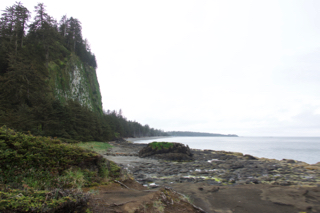 |
| Ketchikan Harbor |
After a great breakfast at Prince
Rupert’s local institution, the Smile’s Café, we took a 3-1/2-mile hike around
the Butze Rapids interpretive trail to see its reversing tidal rapids. Then we visited the quite informative and well-worth seeing Museum
of Northern BC. Having exhausted what we
could do in a single day, we arrived at the ferry nearly three hours prior to
departure. We again met the Australian
couple we had seen on the ferries since Vancouver Island. This time we sat and shared stories while
waiting. It felt like a friendship was
beginning.
 |
| Butze Rapids' reversing tidal rapids near Prince Rupert |
Our ferry to Ketchikan left at 7:45
pm and was scheduled to arrive at 1:45 the following morning. We decided to forego a cabin and simply
snooze in the lounge area… our mistake.
We should have booked a cabin… lesson learned.
We sailed
on the Alaska marine ferry Matenuska,
an old and worn ferry in comparison to Canada’s Northern Adventure. By the
end of the evening, we decided that the lounge chairs must have been designed
by a masochist… they were much like seats on an airplane only with more legroom
and much less padding. It was impossible
to find a comfortable position.
Bleary-eyed
and exhausted, we arrived in Ketchikan around two in the morning and, along
with a half-dozen other rigs, drove straight to the Walmart parking lot to
spend the remainder of night.
Bright and
early, seaplanes taking off woke us up, but the sunshine certainly
brightened our day. We headed downtown
to the visitor’s center, found a parking spot, and walked to the visitor’s
booth.
Downtown Ketchikan was already
buzzing with two cruise ships in port. As
we walked toward the visitor’s booth, the Disney Wonder cruise ship
docked. Soon the boat was alive with
people, boiling out of its decks and onto the docks like the end of a college football game. The streets of Ketchikan began to
overflow. Hawkers peddled their
wares. Tour buses thundered and belched
their way through town. Ducks
(amphibious vehicles), filled with tourists, rumbled towards the harbor. Seaplanes soared overhead, taking tourists to the fjords and other sights. It was simply too much after being ten days
on a small, remote island. We also
discovered that we had arrived in Ketchikan on Memorial Day weekend, which only
added to the chaos.
 |
| Ketchikan's cruise ship harbor |
We ducked into bookstore to find more reading material. Shortly after we arrived, the Australian couple, Liz and Walter, walked through the door. We laughed and told them that we were spending too much time together.
Our new Auzzie friends were having refrigerator problems with their rented rig, so they had opted for the last remaining spot at the RV park. We left them and drove to Totem Bight, a wonderful state park that displayed a variety of replicated totem poles.
Our new Auzzie friends were having refrigerator problems with their rented rig, so they had opted for the last remaining spot at the RV park. We left them and drove to Totem Bight, a wonderful state park that displayed a variety of replicated totem poles.
 |
| Toten Bight State Park, Ketchikan |
 |
| Toten Bight State Park, Ketchikan |
Afterward, we drove to the campground on lovely Ward Lake, figuring we needed to find a camp spot early because of the holiday. It was already full. We drove to Settler’s Cove at the end of the island. It was also full, but we took a lovely hike there. Then we drove up Brown Mountain, expecting to find a pull out or some secluded road for a camp. We found none. Ultimately, we found a pullout on the lake road and spent the night there.
To our surprise during another drive into Ward Lake campground, we noticed several campsites open. Of course, we immediately grabbed one and set up camp. That night, we discovered why so many spots were available…
several nearby campsites were filled with large groups of folks who were extremely
loud and had no problems chopping wood at two in the morning. These folks were so loud that someone must have complained. Law enforcement came to chat with them the
following day.
Monday we drove into Ketchikan early, hoping to avoid the
deluge of cruise ship travelers. We
visited several small museums and walked along Ketchikan’s infamous Creek Street. The street is well known for its history of
brothels and speak easies but is now a destination for souvenir shoppers.
When the crowds began to grow, we headed north. Now that the holiday weekend was over, the
campground was empty, except for a few campers also bound for
tomorrow’s ferry. We strolled along the
lake, drinking in the sunshine and quiet.
 |
| Ketchikan's infamous Creek Street |
We left Ketchikan Tuesday morning on the 11:45 am
ferry. I admit that we were very happy
to do so, particularly with two more cruise ships scheduled to arrive later
that day, each bringing another 5,000 visitors.
Under fair skies, we set our sights for Wrangell Island, hoping for a
bit of serenity.
 |





























